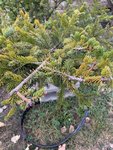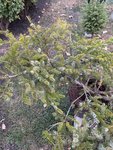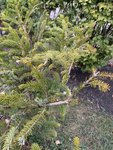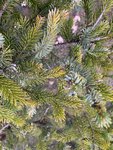SleepChamber
Seed
- Messages
- 2
- Reaction score
- 0
I went to Zanesville, Ohio a week or two ago to look for cheap antique stoneware and clay pots (Roseville, McCoy, etc.) for next spring and stopped at a favorite nursery of mine just to gander. I ended up walking away with a Hinoki, JWP, and a Korean Fir all in 3 gal nursery pots. I know the Korean Fir aren’t favorable for bonsai but I may just keep it as a specimen in my garden. I’ve never actually taken care of this species before and am having issues with it....... all three of the trees I bought have pests right now. I noticed a small web on the Hinoki and the Fir has bag worms which I pinched off and burned. The JWP had a few bag worms too. I’ve treated all trees with Bonide systemic insect spray which hasn’t taken full effect yet.....but this Fir is really scaring me because it is rapidly declining it seems while the others seem strong and healthy albeit the small pests problem . I noticed when watering the Fir for the first time last week that there is some kind of black fabric barrier below it’s topsoil that’s edges surface around the trunk. I tried tugging at it but it seems that roots have now grown through it and removing it would destroy the top inch of its root system ( what the fuck!). Also the weather here in Ohio has been awful for the past week which could be contributing to the trees stress. It’s been 90 degrees during the day and the. 50 to 60 at night with constant winds all day and night. I’ve been giving each tree sufficient water but this fabric barrier around the firs topsoil is like a rubber mat and all of the water pools then drains around the trunk so I’m not really sure how much is being disbursed to the rest of the rootball. The Fir itself has about a 5 foot spread so it’s kind of hard to take it out of the pot to check its roots although I know it’s critical that I look at this point..... here are some photos if anyone has any advice. The nursery owners are not answering their landline or returning my calls because I think they went on vacation. I’m too stingy to bring an arborist around. The most effected side of this tree is the side that faces southwest in my garden so I’m also questioning sun scald from the extreme heatwave this week




